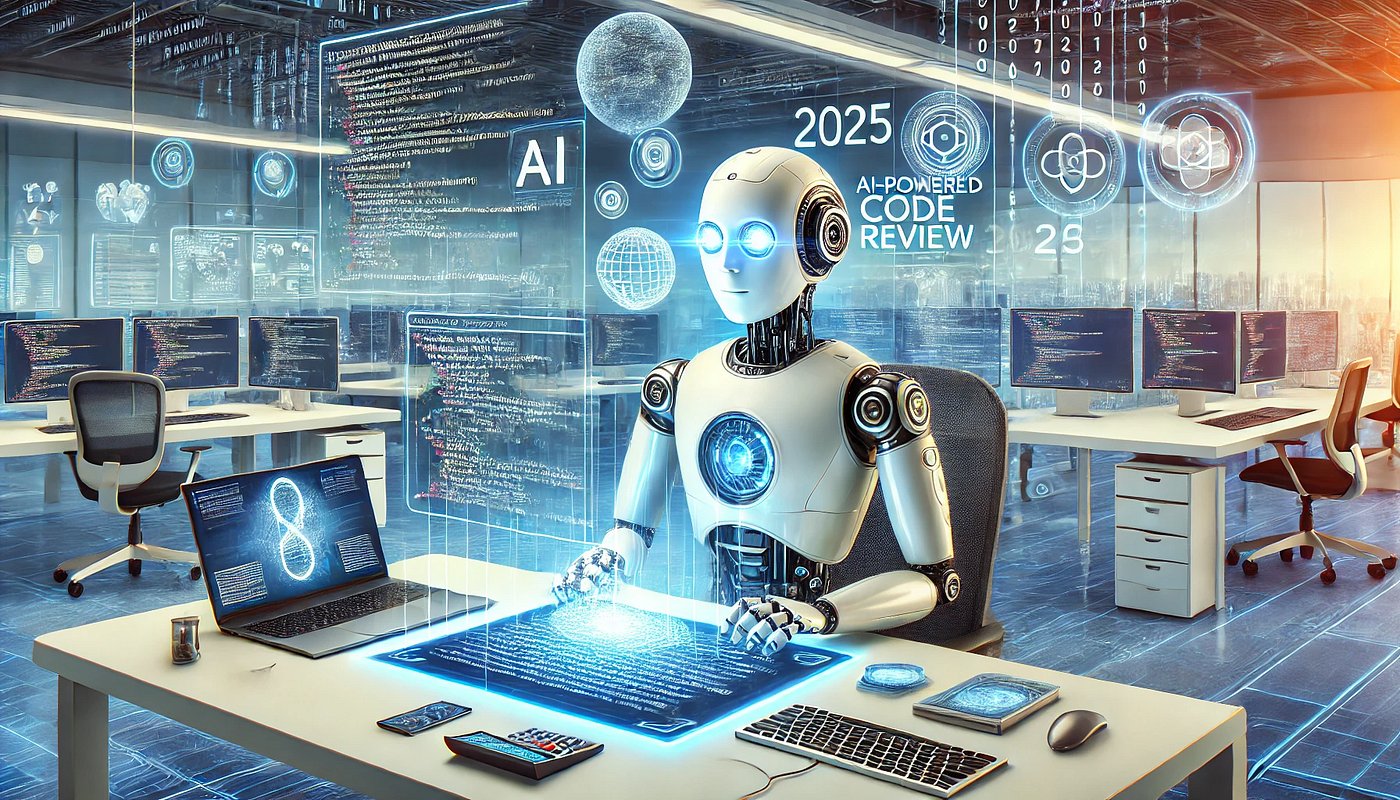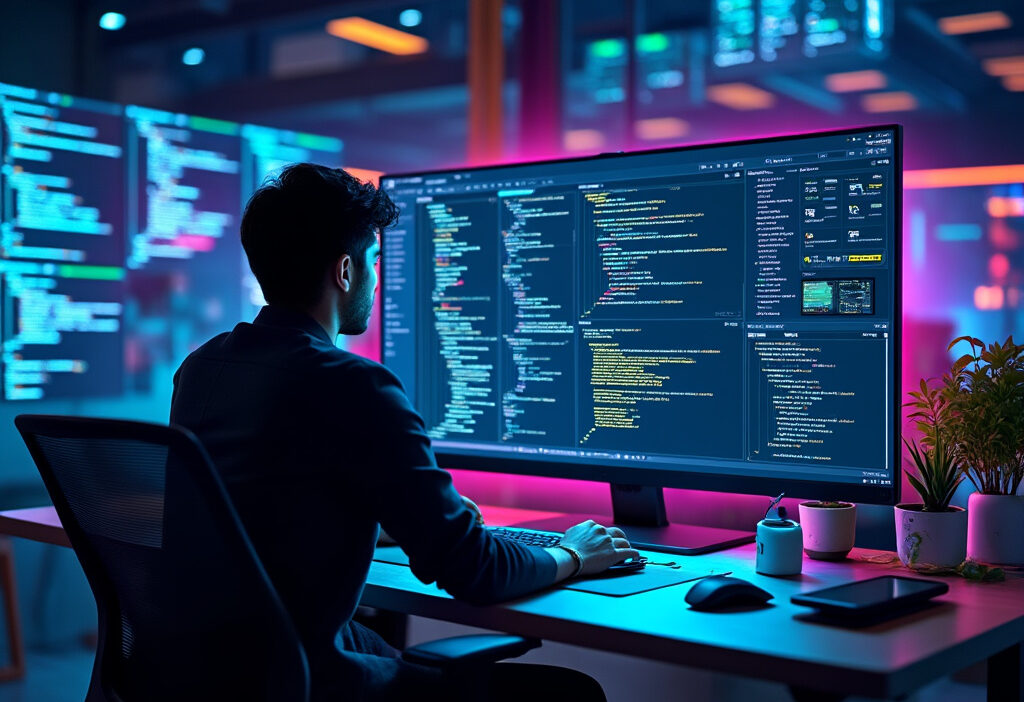AI-Powered Code Reviews Transforming Software Quality and Development Efficiency in 2025
In the rapidly evolving world of software development, AI-powered code reviews are setting a new standard for quality and efficiency. By 2025, these tools are expected to transform how developers write, review, and optimize code, reducing errors and accelerating project timelines. This article explores the advancements, benefits, and future potential of AI in code reviews, offering insights into how this technology is reshaping the industry.
The Rise of AI in Software Development
The integration of artificial intelligence into software development has been a gradual but transformative journey, marked by key milestones that reshaped how engineers write, test, and maintain code. In the early 2010s, AI was primarily confined to academic research and niche applications, but advancements in machine learning (ML) and computational power soon unlocked its potential for mainstream development. Tools like GitHub Copilot and DeepCode emerged as pioneers, leveraging AI to assist with code completion and basic error detection, signaling the beginning of a paradigm shift.
By the mid-2020s, AI had evolved beyond simple suggestions to actively analyzing codebases for vulnerabilities, performance bottlenecks, and architectural flaws. The rise of transformer-based models, such as OpenAI’s GPT and Google’s BERT, enabled AI to understand context and intent in code, much like it did with human language. This breakthrough allowed AI-powered tools to provide context-aware recommendations, reducing the cognitive load on developers and accelerating iteration cycles.
The shift toward AI-driven development was further fueled by the growing complexity of software systems. Traditional manual reviews became unsustainable as codebases expanded, leading to the adoption of AI as a scalable solution. Companies like Meta and Google integrated AI into their CI/CD pipelines, automating code reviews and catching defects before they reached production. These innovations not only improved software quality but also freed developers to focus on creative problem-solving rather than tedious debugging.
As AI continues to mature, its role in software development is transitioning from an assistant to a collaborator, capable of understanding high-level design patterns and even proposing optimizations. The next chapter will delve deeper into how these AI-powered code reviews function, examining the underlying technologies that make them possible.
Understanding AI-Powered Code Reviews
AI-powered code reviews represent a paradigm shift in how developers assess and improve code quality. Unlike traditional manual reviews, which rely on human expertise and are prone to fatigue and oversight, AI-driven tools leverage advanced technologies like machine learning (ML) and natural language processing (NLP) to analyze code systematically. These tools scan repositories, identify patterns, and flag potential issues—ranging from syntax errors to security vulnerabilities—with remarkable precision.
At the core of AI-powered code reviews are ML models trained on vast datasets of high-quality code. These models learn from historical reviews, open-source projects, and organizational best practices to recognize what constitutes “good” or “problematic” code. For instance, they can detect:
- Code smells: Poorly structured or inefficient code that may not break functionality but could lead to maintenance issues.
- Security flaws: Vulnerabilities like SQL injection or buffer overflows that human reviewers might miss.
- Style violations: Deviations from coding standards, ensuring consistency across teams.
NLP enhances these tools by interpreting comments, commit messages, and documentation, providing contextual insights. Some systems even suggest fixes or refactoring options, reducing the cognitive load on developers. Technologies like static code analysis and dynamic execution tracing further refine the process, enabling AI to predict how code will behave in runtime environments.
Leading platforms integrate with version control systems like Git, offering real-time feedback during pull requests. This seamless integration ensures that AI reviews become an organic part of the development workflow rather than an additional step. By 2025, these tools are expected to evolve beyond error detection, offering predictive analytics to foresee technical debt and optimize performance proactively. The result? A faster, more reliable, and scalable approach to maintaining software quality.
Benefits of AI in Code Review Processes
AI-powered code reviews are reshaping software development by addressing long-standing inefficiencies in traditional review processes. By leveraging machine learning and natural language processing, AI tools analyze code with unprecedented accuracy, catching subtle bugs, security vulnerabilities, and performance bottlenecks that human reviewers might overlook. Unlike manual reviews, which are prone to fatigue and bias, AI systems consistently apply best practices and coding standards, ensuring a higher baseline of quality across projects.
One of the most significant advantages is speed. AI can scan thousands of lines of code in seconds, drastically reducing turnaround times. Developers no longer need to wait hours—or even days—for peer feedback, enabling faster iterations and accelerating release cycles. This is particularly valuable in agile and DevOps environments, where rapid deployment is critical. Additionally, AI-powered reviews learn from past mistakes, continuously improving their detection capabilities by analyzing historical data and patterns from previous projects.
Another key benefit is the reduction of human error. While human reviewers bring contextual understanding, they may miss edge cases or overlook repetitive issues. AI complements this by flagging inconsistencies, enforcing style guidelines, and even suggesting optimizations. Tools integrated into CI/CD pipelines provide real-time feedback, allowing developers to fix issues before they escalate.
Beyond efficiency, AI-driven reviews foster knowledge sharing by automatically documenting common pitfalls and recommending fixes, helping junior developers learn faster. Teams also benefit from reduced cognitive load, as AI handles routine checks, freeing engineers to focus on complex problem-solving. With these advancements, AI-powered code reviews are not just improving software quality—they’re transforming how teams collaborate and innovate.
Key Players and Tools in the Market
The AI-powered code review market has seen rapid growth, with several key players emerging as leaders in the space. Among them, Qodo and DeepSeek stand out for their innovative approaches to automating and enhancing code reviews. These tools leverage advanced machine learning models to analyze codebases, identify vulnerabilities, and suggest improvements—transforming how development teams ensure software quality and efficiency.
Qodo distinguishes itself with its context-aware analysis, which goes beyond static code checks by understanding the broader architecture and dependencies of a project. Its AI engine learns from historical project data, enabling it to flag potential issues that might otherwise go unnoticed. Qodo also integrates seamlessly with CI/CD pipelines, providing real-time feedback without disrupting developer workflows.
On the other hand, DeepSeek specializes in deep learning-based pattern recognition, excelling at detecting subtle bugs and anti-patterns that traditional linters miss. Its proprietary algorithms are trained on vast datasets of open-source and proprietary code, allowing it to predict potential defects before they manifest. DeepSeek also offers automated refactoring suggestions, helping developers optimize performance and maintainability with minimal manual intervention.
Other notable tools include:
- CodeGuru by Amazon Web Services, which provides intelligent recommendations for improving application performance and reducing costs.
- GitHub Copilot X, which extends its AI pair programming capabilities to code reviews, offering inline suggestions and explanations.
- SonarQube with AI enhancements, combining static analysis with machine learning to detect security vulnerabilities and code smells more accurately.
These tools are shaping the future of software development by reducing manual review burdens while increasing precision. As AI continues to evolve, their capabilities will further integrate into developer ecosystems, reinforcing the shift toward smarter, more efficient code quality assurance.
How AI Enhances Code Quality
AI-powered code reviews are fundamentally reshaping how developers ensure high-quality software in 2025. By leveraging machine learning and advanced static analysis, AI tools go beyond traditional linting and manual reviews, offering deep, context-aware insights that elevate code quality at every stage of development.
One of the most impactful ways AI enhances code quality is through bug detection. Unlike rule-based analyzers, AI models learn from vast repositories of code to identify subtle patterns that lead to vulnerabilities, such as memory leaks, race conditions, or security flaws like SQL injection. For example, tools now flag not just syntax errors but also logical inconsistencies—like mismatched API responses or improper error handling—that humans might overlook.
AI also excels at suggesting optimizations. By analyzing performance bottlenecks, it recommends algorithmic improvements or caching strategies tailored to the codebase. A developer writing a sorting function might receive an AI-generated suggestion to switch from O(n²) to O(n log n) logic, significantly boosting efficiency.
Enforcing coding standards is another area where AI shines. Instead of relying on rigid style guides, AI tools adapt to team preferences, automatically correcting deviations in naming conventions, documentation, or architectural patterns. This ensures consistency across large teams without manual oversight.
Moreover, AI-powered reviews reduce technical debt by detecting code smells—repetitive logic, overly complex functions, or deprecated libraries—and proposing refactoring solutions. This proactive approach prevents minor issues from snowballing into costly rewrites later.
With these capabilities, AI doesn’t just catch errors—it actively mentors developers, fostering better coding habits while accelerating delivery. As we’ll explore next, these advancements also redefine collaboration, making real-time feedback and collective learning seamless.
The Role of AI in Team Collaboration
AI-powered tools are reshaping team collaboration in software development by breaking down traditional barriers and fostering seamless interaction among developers. Unlike static code reviews of the past, AI-driven platforms now enable real-time feedback loops, allowing teams to address issues as they emerge rather than waiting for scheduled reviews. This immediacy not only accelerates development cycles but also enhances collective learning, as developers gain instant insights into best practices and potential pitfalls.
One of the most transformative aspects is AI’s ability to bridge knowledge gaps within teams. Junior developers, for instance, receive contextual suggestions that align with senior engineers’ expertise, reducing dependency on manual mentorship. Meanwhile, AI-generated summaries of complex code changes help distributed teams stay aligned, ensuring everyone understands the rationale behind modifications—even across time zones.
Key collaborative benefits include:
- Automated context sharing: AI tools document decisions and flag inconsistencies, creating a living knowledge base that evolves with the codebase.
- Personalized recommendations: By analyzing individual coding patterns, AI tailors feedback to each developer’s skill level, promoting growth without overwhelming them.
- Conflict resolution: Neutral AI suggestions depersonalize critiques, turning potential disagreements into objective discussions about code quality.
However, this shift isn’t without challenges—over-reliance on AI could erode critical thinking, a theme explored in the next chapter. Yet in 2025, the synergy between AI and human collaboration is proving indispensable, transforming code reviews from isolated tasks into dynamic, team-wide conversations that elevate both quality and efficiency.
Challenges and Limitations of AI Code Reviews
While AI-powered code reviews have significantly enhanced software quality and development efficiency, they are not without challenges and limitations. One of the most pressing issues is the over-reliance on AI, which can lead to complacency among developers. When teams trust AI tools too much, they may skip manual reviews or critical thinking, assuming the AI has caught all issues. This can result in overlooked vulnerabilities or design flaws that require human intuition to identify.
Another major challenge is the prevalence of false positives and negatives. AI models, despite their sophistication, can misinterpret code context, flagging benign patterns as errors or missing subtle bugs. This creates noise in the review process, forcing developers to waste time verifying incorrect alerts. Conversely, false negatives—where the AI misses actual defects—can undermine trust in the tool, requiring human reviewers to double-check its outputs.
The need for human oversight remains critical. AI excels at pattern recognition but struggles with nuanced decisions, such as evaluating code maintainability, architectural coherence, or business logic alignment. Human reviewers must still assess whether suggested fixes align with project goals and team standards. Additionally, AI tools often lack domain-specific knowledge, making them less effective in specialized fields like embedded systems or legacy codebases.
Finally, bias in training data can skew AI recommendations. If the model was trained on limited or outdated codebases, it may favor certain coding styles or overlook modern best practices. Teams must continuously fine-tune these tools to align with their unique workflows.
Despite these challenges, AI-powered code reviews remain transformative—but they work best as a complement, not a replacement, for human expertise. The next chapter will explore how emerging trends aim to address these limitations while pushing the boundaries of AI-assisted development.
Future Trends in AI-Powered Code Reviews
As AI-powered code reviews continue to mature, 2025 is poised to bring transformative advancements that reshape software development workflows. One key trend is the evolution of multimodal AI models, which combine code analysis with contextual understanding from documentation, commit messages, and even developer comments. These models will reduce false positives by interpreting intent rather than just syntax, addressing a limitation highlighted in earlier discussions.
Another emerging innovation is real-time, in-IDE code reviews. Instead of waiting for pull requests, AI will provide instant feedback as developers type, catching issues early and reducing rework. Tools like GitHub Copilot are already hinting at this future, but 2025 will see deeper integration with linters, debuggers, and testing frameworks, creating a seamless feedback loop.
Personalized AI reviewers will also gain traction, adapting to team coding standards and individual developer styles. By learning from historical data, these systems will minimize noise and prioritize high-impact suggestions, balancing automation with human oversight—a critical need noted in previous chapters.
Additionally, AI-driven code summarization will streamline peer reviews, automatically generating concise explanations of changes. This reduces cognitive load for human reviewers, fostering collaboration without sacrificing quality.
Finally, expect tighter integration with DevOps pipelines, where AI reviewers will not only assess code but also predict deployment risks by analyzing dependencies, performance metrics, and security vulnerabilities. This proactive approach aligns with the growing demand for shift-left practices.
These trends underscore AI’s role as a collaborative partner rather than a replacement for developers. As the next chapter will illustrate through real-world cases, organizations adopting these innovations are already seeing measurable gains in efficiency and software quality.
Case Studies of Successful Implementations
Several leading organizations have already embraced AI-powered code reviews, demonstrating measurable improvements in software quality and development efficiency. Google, for instance, integrated an AI-based system called Critique into its code review workflow. The tool analyzes millions of past code changes to provide contextual suggestions, reducing review time by 30% while catching subtle bugs that human reviewers often miss. Engineers reported higher confidence in their merges, and the system flagged potential performance regressions before they reached production.
Microsoft adopted GitHub Copilot for automated code reviews, leveraging OpenAI’s models to scan pull requests for security vulnerabilities and stylistic inconsistencies. Teams using the tool saw a 40% reduction in post-deployment defects, with AI catching issues like memory leaks and race conditions early. The system also learned team-specific coding conventions, ensuring consistency across large codebases.
At Stripe, AI-powered static analysis tools were integrated into CI/CD pipelines, automatically flagging anti-patterns and suggesting optimizations. The result was a 25% faster release cycle, as developers spent less time manually debugging. The AI also identified recurring issues, enabling teams to proactively refactor problematic modules.
Smaller firms like Shopify have also benefited, using AI to prioritize high-risk changes. Their system assigns severity scores to pull requests, allowing reviewers to focus on critical updates first. This reduced bottlenecks and improved collaboration between distributed teams.
These case studies highlight how AI-powered reviews aren’t just theoretical—they’re delivering tangible gains. The next chapter will explore how teams can prepare for this shift, ensuring smooth adoption and maximizing the benefits of AI-driven development.
Preparing for an AI-Driven Development Future
As organizations increasingly adopt AI-powered code reviews, developers and teams must prepare for this shift to maximize its benefits. Transitioning to an AI-driven workflow requires more than just tool adoption—it demands a cultural and procedural evolution. Here’s how teams can effectively integrate AI into their development processes.
Start with incremental adoption. Rather than overhauling existing workflows overnight, introduce AI tools gradually. Begin by using AI for low-risk tasks, such as identifying syntax errors or enforcing basic style guidelines. This allows teams to build trust in the technology while minimizing disruption.
Invest in training and upskilling. AI-powered tools often introduce new paradigms, such as natural language prompts for code suggestions or automated refactoring. Developers should familiarize themselves with these features through workshops, online courses, or hands-on experimentation. Platforms like Coursera, Udacity, and GitHub’s own documentation offer valuable resources for mastering AI-assisted development.
Establish clear guidelines for AI collaboration. While AI can catch bugs and suggest optimizations, human oversight remains critical. Define when and how AI-generated feedback should be reviewed, ensuring accountability. For example, teams might require manual validation for security-related suggestions or complex architectural changes.
Leverage AI for continuous improvement. Use AI-generated insights to identify recurring issues in your codebase, such as frequent performance bottlenecks or security vulnerabilities. Addressing these patterns proactively can elevate overall code quality over time.
Finally, foster a culture of experimentation. Encourage developers to explore AI tools creatively, whether by automating repetitive tasks or using predictive analytics to estimate review times. Teams that embrace AI as a collaborative partner—rather than a replacement—will unlock its full potential in enhancing both software quality and development efficiency.

Conclusions
As we look toward 2025, AI-powered code reviews are poised to become an indispensable part of software development. By automating tedious tasks, enhancing accuracy, and fostering collaboration, these tools not only improve code quality but also free developers to focus on innovation. The future of coding is here, and it is powered by artificial intelligence.



